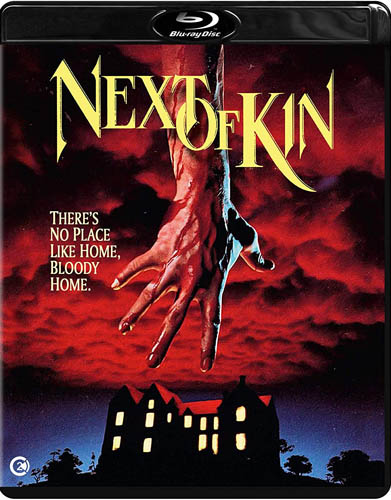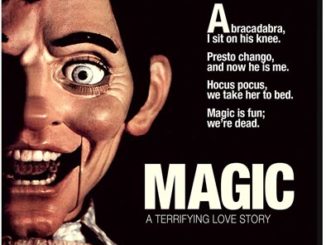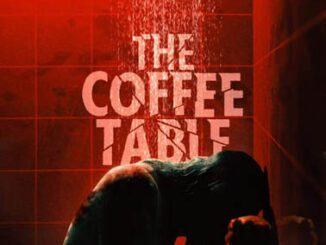Next of Kin (1982)
Directed by: Tony Williams
Written by: Michael Heath, Tony Williams
Starring: Alex Scott, Gerda Nicolson, Jacki Kerin, John Jarratt
Australia
AVAILABLE ON BLU-RAY, DOWNLOAD AND ON-DEMAND: 25th March, from SECOND SIGHT
RUNNING TIME: 89 mins
REVIEWED BY: Dr Lenera, Official HCF Critic
Linda comes back to her sleepy home town in order to take possession of Montclare, a home for the elderly which she’s inherited as a result of her mother’s death. She’s rather overwhelmed by everything and considers even selling the place. However, the arrival of a new resident is quickly followed by the finding of another resident drowned in his bath tub. Linda can’t shake the feeling that someone is watching and listening to her. As a diversion she begins to read her mother’s diaries, but discovers that things which happened twenty years ago are beginning to repeat themselves….
When our webmistress Bat asked me if I was interested in reviewing a film called Next Of Kin I was most happy to do so, as I’m very fond of the Patrick Swayze/Liam Neeson actioner from 1988 – until she informed me that this was a different Next Of Kin, an Australian horror from 1982. In fact it’s a film that I’d never heard of at all even though Quentin Tarantino had apparently extolled its virtues, though the latter may not be surprising as I haven’t seen Not Quite Hollywood the Australian exploitation movie documentary in which he talked about it either. He says that “it has a very unique tone and the closest equivalent to this tone is The Shining”. While he’s usually on the mark, I respectively disagree with him here. Thoughts of several great horror films went through my head as I watched Next Of Kin, but The Shining wasn’t one of them. At times the most prominent film it reminded me of in atmosphere, style and pacing was that classic early slasher Black Christmas, though it’s really closer to a giallo than a proper slasher, and is perhaps more than anything else an Old Dark House chiller, with some plot elements and situations that date back to the silent era.
Tarantino is definitely right about something though – there’s something unique about this film’s tone – and it’s bloody good, so much so that around half way through I got annoyed with myself for not having known about it before. Horror Cult Films was partly founded on the desire of its writers to try to spread the word about good films, especially of a horror nature, that had flown under the radar and not been seen by enough people – and which therefore in our opinion hadn’t gotten their due. Well, at least I can sing the praises of Next Of Kin now, even if I can’t locate much information about it to impart to you. It’s a slow burner to be sure, but unless you really do require a scare a minute that shouldn’t be a problem because director Tony Williams imbues things with such a sense of dread that I think most viewers will be quickly drawn into the waking nightmare experienced by its lead character – as well as be very impressed by how well Williams handles things, especially his use of silence and quiet, and his ability to make the most of his prominent setting. I hadn’t heard of this director either, but he knows exactly what he’s doing with this genre – and yet he only ever made one other feature film and that certainly doesn’t look it was horror. He could have has a career in the genre – or at least done a Bob Clark and made two other genre movies before turning to crap. Quite often when I see a film like this, I shake my head to myself and wonder what the likes of Mario Bava or Dario Argento would have done with the material because the film was falling so short. But not this one, and yet that quirkiness that exists in many Australian movies still manages to find its way into this one.
We begin very unnervingly indeed with a slow-motion scene of a woman putting petrol in her car before walking round to the other side of the vehicle and getting in. She has a few cuts on her neck and a bloody great bruise on the side of her face. As we hear a voice-over saying: “to my daughter, I leave my entire inheritance”, it seems that this is our heroine’s mother that we’re seeing. Then we meet Linda and see her heading for her home town to take over the rest home that her recently deceased mother left for her. She enters a diner in what is a bit of an odd scene with some slightly disjointed editing, random cuts to people and even time seeming to be manipulated, but it seemed to me that this was less another example of technically imperfect film-making then an attempt to make the viewer feel rather disorientated like Linda. She feels very awkward in this town where nothing seems to have changed in twenty years except for the addition of a public toilet, and this certainly doesn’t change when she arrives at the rest home where it suddenly starts to pour down and become so windy that it’s almost impossible to take in the washing blowing all over the place. It’s not long before she finds herself walking up a spiral staircase to a creaky old room with a swinging lamp while the gale outside gets ever louder – god, for me this kind of stuff never get old even though it really is ancient. The light suddenly and unusually illuminates a face watching her before Linda turns round to see it – but it’s only Connie the chief nurse. Then, on another dark and stormy night, despite the fact that Linda stipulated that Connie shouldn’t take in anyone else, a new resident arrives– an old woman in a wheelchair helped by her nephew.“Wasn’t your aunt happy in her last home”? the nephew is asked.“They weren’t happy” is the reply.
Linda sees somebody watching her from a distance, the time that she does while out in the woods being a good example of the way that Williams likes to subvert expectations in his scenes. The camera comes up behind her so that we think that someone – possibly Barney the old boyfriend she’s reunited with, possibly not – is going to be revealed when Linda turns round, but instead the camera just circles around the front of Linda – who’s then surprised by Barney a few seconds later! Also very well handled is the discovery of the first body by Lance the now elderly gardener who accidentally steps on the corpse in the bath. Linda soon thinks that she could be losing her mind when taps seem to overflow [water is definitely a major theme in this film], lights are turned off and heavy breathing is heard down the phone. The lengthiest of these set pieces around the middle of the film is quite simply a tour de force of working up the viewer into a sweat, with brilliant usage of devices like a cat who seems to hide from the killer and an old man uncannily banging on the window in a moment almost as effective as that scene in Salem’s Lot that scared so many of us shit-less when we were kids. And eventually, as the music score and the editing become faster, we do get a truly white-knuckle denouement that’s so effective that one can almost that, while most things are kind of answered, some of them are done so in a rather haphazard way – though you could also take that as Williams and his co-writer Michael Heath just believing that viewers ought to be intelligent enough to work everything out for themselves. Though those dream flashbacks that Linda experiences remain vague, especially the sexual excitement she seems to have whilst having them – I mean what’s up with that?
I reckon that some really clever viewers will piece together at least some of the mystery, while there are a few moments of absurdity, like a physiologically daft scene wherein a person’s blood becomes the water spouting out of a fountain, and isn’t it convenient when diaries are left open to exactly the right page? But when the atmosphere and suspense are so strong, when there’s such brilliant employment of sound such as when the killer is walking down the corridors of Montclare which recalls the creepiest bit from The Haunting, the horror lover shouldn’t really complain too much, even if we only see the aftermath of the murders and other vicious acts like an eye-stabbing. Cinematographer Gary Hansen does great work throughout with a camera that often glides around, such as a long wall-hugging draw away from Linda’s nervous eyes as she peers into a hallway, and he even gives us an eerie variation on Vertigo’s famous pulling in and pulling back device as a hallway sometimes seems to get longer in both the foreground and the background. Slow motion is employed very well too. The very up-front electronic music score by Tangerine Dream’s Klaus Schulze initially seemed a bit at odds with what was happening on screen to me, but the music is so good, be it dreamy ambient tracks or pulsating electronic, that I soon got used to it. And Jacki Keren, who seems to have done all her other work for TV, manages to make Linda vulnerable and sympathetic yet also with just a bit of an edge to her, as if something could be going on beneath the surface. It wouldn’t have been that easy to get the balance right.
The low budget doesn’t really hamper things at all, and an explosion reflected onto a highway sign instead of being seen fully was actually an accident because the special effects guys activated it too soon. Next Of Kin was a real find for me [well, it wasn’t really a find but you know what I mean]. Despite some bits of awkward plotting here and there, it attains a level of filmmaking that ‘s considerably higher than many of its contemporaries, being quite a few steps above mere professionalism and often becoming true stylisation, yet not letting its grand guignol Gothic concerns drown the archetypal laid back gruffness of rural Australia that’s so appealing about films that take place in this setting. And it’s pretty scary too. I’d say it’s an unsung [Quentin notwithstanding] minor classic that’s almost an unsung major one.
Rating: 









Second Sight’s release of Next Of Kin uses the Australian Umbrella Entertainment restoration that came out in that country last year and which was also used for Severin Film’s Region ‘A’ release that was released in North America last month. The film looks fairly sharp and very detailed despite the often muted colour schemes used [probably so that bursts of red stick out] that tend to emphasise brown, except for the slow motion shots that are of noticeably less quality and which obviously couldn’t be improved. Grain is well managed. There are two audio options. On my simple set-up the original mono mix played better than the 2.0 mix, though I could tell that with the right equipment the sound effects and score would be nicely spread out.
With one very minor exception, all the Umbrella special features have been retained, and there are plenty of them, beginning with not one but two audio commentaries. The first features Williams and producer Tim White. Be warned – there are a lot of often lengthy gaps in this track with Williams [White says very little] often seemingly running out of things to say. What he does say though is consistently interesting, from the project’s origins as a black comedy about caterers who went around poisoning people in old people’s homes, to the chief visual inspirations being Blood And Roses and Last Tango In Paris, to the film’s minimal release due to the financing company going bust, to Schulze having his score rejected in favour of the Schulze pieces they’d temp-tracked the movie with. He also says that he made no more horror films because he didn’t want to be typecast as one. Shame. The second audio commentary is even better. It features cast members Kerin, John Jarratt [Barney] and Robert Ratti along with the Not Quite Hollywood director Mark Hartley, who sometimes acts as moderator but for most of the time doesn’t need to as the others are constantly chatting. Nice tidbits include Ratti being asked by Williams to study the Yorkshire Ripper for his character background, and Jarratt, who talks the most and is sometimes prone to vulgarity, taking candidly about the problems with the Australian film industry at the time. There’s only a small amount of repetition from the first commentary, and no major gaps.
The rest of the special features begin with Return to Montclare which compares the locations then and now in considerable detail, and I mean considerable. Backed by two of the most atmospheric of the score tracks, it has much more of a mood to it than these things usually do. The extended interviews are longer versions of interviews with Williams and Jarrat that appeared in Not Quite Hollywood. The majority of what they say is also heard in the commentaries, but it’s usually more detailed, and we do learn a few new things. The Deleted Scenes is actually just one scene and shown only as contact sheets from the continuity stills. While Williams obviously thought it was too much, this exciting addition to the climax should definitely have remained in the film in my opinion. Then we get two very early Williams documentaries in black and white made as part of a five part TV series called Survey in 1971. Getting Together looks at the need for humans to socialise, showing as examples various clubs and gatherings in New Zealand. I wasn’t overly hot on this, which seemed to be stating the bleeding obvious, but it’s certainly well put together for a first documentary. Much better to me eyes was The Day We Landed on the Most Perfect Planet in the Universe which examines the minds of children and how their imaginations run riot. With Williams himself in the role of the teacher trying to start things off, it’s rather lovely and shows what we have lost as adults. And after the trailers and alternate German Opening Credits we get Before the Night is Out. This is the full ballroom footage briefly glimpsed on a TV in the film, and we learn that it was shot specifically for the film.
Next Of Kin is a film that anyone who loves horror ought to check out, while Second Sight’s disc is full of special features. Highly Recommended.
SPECIAL FEATURES
*Audio commentary with Director Tony Willams and Producer Tim White
*Audio commentary with cast members John Jarratt, Jackie Kerrin, Robert Ratti and Not Quite Hollywood Director, Mark Hartley.
*Return to Montclare: Next of Kin Shooting locations revisited
*Extended interviews from Not Quite Hollywood
*Deleted Scenes
*Tony Williams shorts from 1971: Getting Together + The Day We Landed on the Most Perfect Planet in the Universe
*Original Theatrical Trailer
*VHS Trailer
*German Trailer
German Opening Credits
*Before the Night is Out – Complete ballroom dancing footage from 1978
*Image Gallery








Be the first to comment